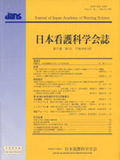Japanese
English
- 販売していません
- Abstract 文献概要
- 参考文献 Reference
- サイト内被引用 Cited by
要旨
研究目的:本研究は,小児看護における卓越した技を探求し,看護師のエキスパートネスをモデル化することを目的に行った.
研究方法:Flickのエピソードインタビューの方法を参考に行った.小児看護領域で5年以上の臨床看護師経験をもち,修士修了または修士在学中の計12名に対し,研究の趣旨を説明し,同意を得たうえで面接を行った.データ収集期間は,2003年6~10月であった.
結果および考察:参加者の語った15例を分析した結果,5つのモデルと一連の看護実践の流れおよびその要素を抽出した.5つのモデルは,(1)子どもとのつながりが見えにくい家族に対し,子どもの力を引き出すことができる糸口を見つけて示すモデル,(2)残された時間が少ない家族にとって大事なことを見つけ出し,周りを巻き込みながらケアするモデル,(3)いつもと様子の違う子どもや家族にとって今大事なことをタイミング良く見つけ,その場の判断で道筋をつけて後押しするモデル,(4)子どもが満足できない状況が繰り返され,通常のケアが適用できない時に,周囲と共有しやり方を変えるモデル,(5)子どもや家族の気持ちと状況とのズレを確認し,モデルを示しながら関わり,ケアを共有していくモデル,であった.
各モデルを構成する一連の看護実践には,(1)気になる,(2)臨床判断,(3)ケア,(4)方向性の確認,(5)システムへの働きかけ,(6)効果とその確認の6つの要素があった.このプロセスで看護師は,気になった場面を解釈し,子どもと家族の示す行動の意味を見出して状況を捉え直し,ケアの方向性を決定していた.そして看護師は,子どもの満足や子どもと家族が納得する状態を具体的なゴールに定め,それらが子どもと家族にとって最善の利益となるようにケアを展開していた.さらに,直接的なケアやその場の関わりだけでは解決が困難な場合には,システムに働きかけてケアを展開し,効果を出していた.
本研究のモデルは,判断やケア,関わりを,「どのように」行ったのかを看護師が見極めながら実践を進めていくことができるものである.
Abstract
Objective: The objective of this study was to describe the nursing art on the child and family nursing and to develop nursing art models that describe the expertise of nurses.
Method: This study employed Flick's episodic interview method. Twelve pediatric nurses, all of whom were either graduate students or master's degree holders with five or more years of clinical experience, participated in this study. Data were collected in 2003.
Findings and Discussion: Fifteen cases were analyzed. Five nursing art models and the process of nursing actions were identified. Model-1: Identifying the cue that reveals the potential of children, and showing it for families of which the relationships with children are weak. Model-2: Identifying matters of great interest to children or families when their time is limited, moreover, letting other staff involved in the care. Model-3: Identifying the chief present concerns of families in time, and directing them based on clinical judgment when children/families look different from as usual. Model-4: Sharing thoughts with others and altering the nature of care when the usual care is not applicable in the case of children who are always unsatisfied about situations. Model-5: Confronting the gap between the feelings of children/families and the situations they are in, modeling for staff members, and sharing the delivery of care.
The process of each model is constructed with the following series of nursing actions: (1) being sensitive to situations, (2) clinical judgment, (3) nursing care, (4) confirming the direction of nursing care, (5) approaching the team members, and (6) nursing outcomes and confirming them. In this process, the nurses interpreted the situations they were attention to, explored the meaning of the behaviors of children and families, re-interpreted the situations, and decided upon the direction of nursing care. Ensuring the satisfaction and gaining the approval of children and families were set as goals to guarantee the best interests of them. Furthermore, nurses operated the systems in difficult cases in order to achieve effective outcomes.
Each nursing art model facilitates the nursing practice by examining “how” clinical judgment and nursing approach are determined.
Copyright © 2007, Japan Academy of Nursing Science. All rights reserved.


